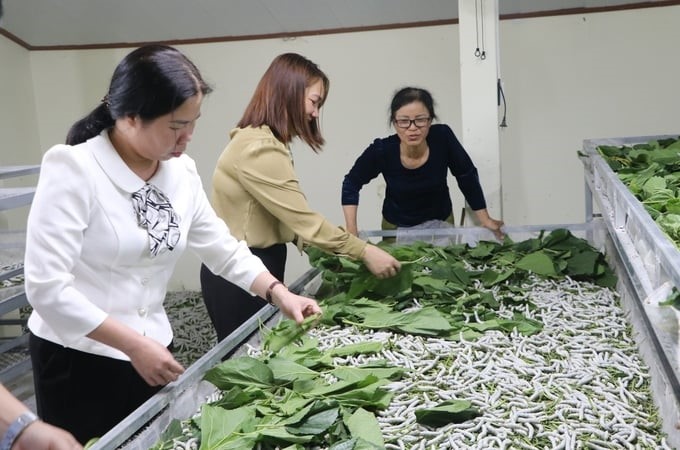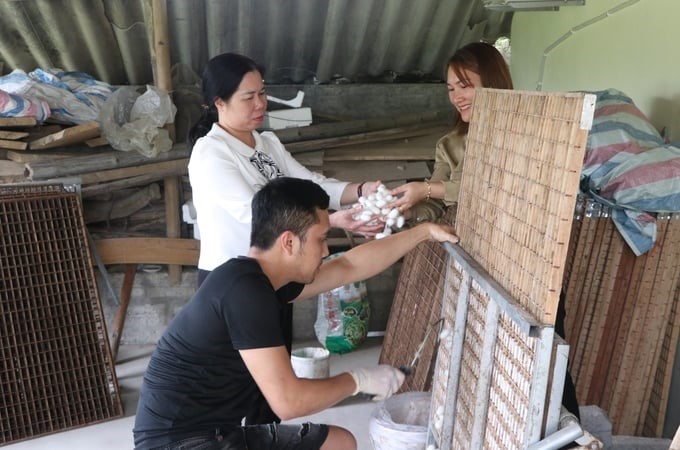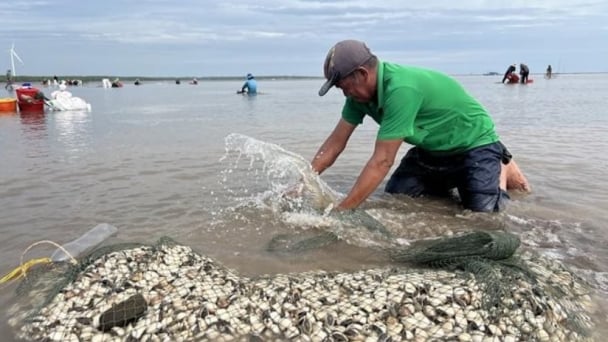May 28, 2025 | 20:06 GMT +7
May 28, 2025 | 20:06 GMT +7
Hotline: 0913.378.918
May 28, 2025 | 20:06 GMT +7
Hotline: 0913.378.918
The area of mulberry trees in Tran Yen district (Yen Bai) is currently about 900 hectares. Some communes have large, concentrated mulberry-growing and silkworm-raising areas, such as Tan Dong, Bao Dap, Dao Thinh, Viet Thanh, Y Can, Quy Mong, and Hoa Cuong.
Mr. Nguyen Van Manh, Head of the Tran Yen Department of Agriculture and Rural Development, said: The whole district has more than 1,500 households growing mulberries to raise silkworms. With the support of the province and district, up to now, hundreds of households have applied scientific and technical advances in selecting seeds, planting, caring for mulberries, techniques of silkworm raising, cocoon creation, and harvesting. People’s process of raising silkworms is increasingly modern, helping them achieve "2 reductions, 3 increases", including reducing investment costs and labor and increasing productivity, output, and quality of silkworm cocoons.

The new mulberry variety GQ2 from the Vietnam Sericulture Research Centre is widely grown in Tran Yen. Photo: Thanh Tien.
In recent years, Tran Yen district has continuously tested and built a model of planting many new mulberry varieties crossbred by the Vietnam Sericulture Research Centre, such as hybrid mulberry varieties grown with seeds VH9, VH13, VH15, and GQ2; and imported mulberry varieties such as Ha No. 7, Sa Nhi Luan, and Que Uu. Currently, the concentrated mulberry raw material area has selected suitable varieties, mainly Sa Nhi Luan, GQ2, and Que Uu (accounting for over 70% of the area). These mulberry varieties have the advantage of large, thick, nutritious leaves, giving good-quality silkworm cocoons.
In addition, in mulberry growing, the local agriculture sector regularly organizes technical training classes and guides people to grow to ensure standard density, comply with intensive technical measures, and use specialized fertilizer NPKS (14-5-6+5S+TE). This helps mulberry trees balance nutrition, grow well, have thick leaves with lots of resin, and limit diseases in silkworm breeding.

The application of raising silkworms on sliding trays helps increase productivity and output per farming room area. Photo: Thanh Tien.
Regarding silkworm raising, people have now effectively applied the two-stage silkworm farming model, including concentrated baby silkworm raising and adult silkworm raising. Ms. Nguyen Thi Hong Le, owner of a concentrated silkworm rearing facility in Viet Thanh commune (Tran Yen district), said: "Previously, when there was no household to raise baby silkworms, 2-stage silkworm raising caused many silkworm-rearing households to lose income because raising baby silkworms is very difficult. Without hygiene assurance and proper techniques, silkworms will be disease-infected, leading to the failure of the entire brood. Therefore, my family raised silkworms from age 1 to age 3, then supplied them to households raising large silkworms from age 4. The households will raise silkworms for one more week until the silkworms are ripe, create cocoons, and are ready to be harvested. This helps minimize risks in the process of raising baby silkworms".
Since 2020, the Tran Yen Agricultural Development Support Service Center has successfully applied the model of raising silkworms on sliding trays. This model saves 30% of the silkworm housing area; reduces the labor of caring for and raising silkworms; adjusts the microclimate in the silkworm-rearing house; and limits humid weather in the spring crop; and waters the floor when the weather is hot. Thereby making silkworms less infected with diseases and increasing productivity and the quality of silkworm cocoons.

Ms. Nguyen Thi Huan, Director of Quy Mong Mulberry Cooperative, feeds silkworms on the sliding tray. Photo: Thanh Tien.
According to Ms. Nguyen Thi Huan, Director of Quy Mong Mulberry Cooperative, the application of raising silkworms on sliding trays helps silkworm-rearing households minimize labor, not have to lift baskets up and down. In addition, this model saves space, helping rearing households increase productivity and output in the same area of the farming room.
One of the important steps in the silkworm raising process is using “Ne” (a tool made of thinly woven wattle) for silkworms to wrap cocoons. Currently, over 90% of households in the district have used square wooden Ne to basically replace the previous Ne types. This contributed to reducing labor, reducing the situation of double cocoons, reaching a high rate of good cocoons and white cocoons, and a high selling price.
Mr. Nguyen Van Ha in Lan Dinh village (Viet Thanh commune) shared: Square wooden Ne have many outstanding advantages, such as being easy to make, not having to pitch, and reducing the time to collect cocoons (about 3 minutes to harvest one Ne while bamboo Ne takes 20 minutes or more). Each silkworm wraps its cocoon in a separate cell, so the cocoon is more uniform, the cocoon color is beautiful, and the value is higher.

Using square wooden Ne helps reduce the time to collect cocoons and gives better-quality silkworm cocoons. Photo: Thanh Tien.
Mr. Nguyen Van Manh, Deputy Head of the Tran Yen Department of Agriculture and Rural Development, said that up to this point, it can be affirmed that 2023 is the most successful year for mulberry growers in Tran Yen in terms of productivity, output, and cocoon price.
Since the establishment of a silk cocoon processing factory in Bao Dap commune (Tran Yen district), the price of cocoons has always been stable at a high level, ranging from VND 150,000 to VND 170,000/kg. From the beginning of the year until now, cocoon output in Tran Yen district has reached over 1,250 tons. The whole year's cocoon output is estimated at over 1,400 tons, worth over VND 200 billion. The district is continuing to strive to expand the mulberry growing area for silkworm raising to 1,000 hectares by 2025 and strive for an annual cocoon output of over 2,000 tons, worth over VND 300 billion.
Translated by Huyen Vu Thu

(VAN) FAO’s Director-General addresses the 5th Baghdad International Water Conference.
/2025/05/26/1716-4-nongnghiep-191706.jpg)
(VAN) Chain linkages, technological innovation, and raw material zoning are three strategic pillars for the coconut industry to strongly develop and elevate its position on the global agricultural map.
![Advanced mariculture – an inevitable trend: [4] Accompanied by scientists](https://t.ex-cdn.com/nongnghiepmoitruong.vn/608w/files/sohk/2025/05/13/1941-pgsts-vo-van-nha-140958_717.jpg)
(VAN) According to Assoc. Prof. Dr. Vo Van Nha, Director of the RIA III, the development of advanced offshore mariculture is no longer an option but an essential path for Vietnam’s fisheries sector.

(VAN) Vietnam is intensifying the development of mollusk farming areas that meet international standards, aiming for sustainable growth and enhancing its export position in the global seafood market.
![Advanced mariculture – an inevitable trend: [3] Policy-driven momentum](https://t.ex-cdn.com/nongnghiepmoitruong.vn/608w/files/doanhtq/2025/05/21/0104-0616-0348-nuoi-bien-170339_789.jpg)
(VAN) To ensure the success of offshore mariculture that uses advanced technologies, it is essential to establish supportive policies that inspire both individuals and enterprises to invest with confidence.
![Advanced mariculture – an inevitable trend: [2] Outstanding results](https://t.ex-cdn.com/nongnghiepmoitruong.vn/608w/files/sohk/2025/05/12/4632-4136-nuoi-bien-11-164117_819.jpg)
(VAN) Pilot models of high-tech offshore mariculture in Vietnam, particularly in the South Central Coast region, have demonstrated exceptional economic returns and sustainability, setting a new direction for the country’s aquaculture industry.
![Advanced mariculture – an inevitable trend: [1] Moving offshore](https://t.ex-cdn.com/nongnghiepmoitruong.vn/608w/files/phucpm/2025/05/18/0252-2436-nuoi-bien-6-162148_783.jpg)
(VAN) Mariculture using advanced technology and moving offshore is an inevitable trend, as nearshore areas increasingly reveal limitations.